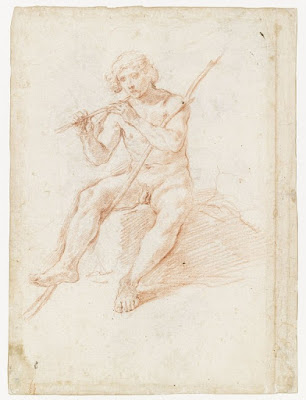 |
| Guido Reni Half-Length Figure Study ca. 1617 drawing (study for painting, Hercules on the Pyre) Musée du Louvre |
 |
| Antonio Viviani Sheet of Figure Studies before 1620 drawing Musée du Louvre |
 |
| Palma il Giovane Study of Sleeping Figures before 1628 drawing Musée du Louvre |
 |
| Palma il Giovane Study of Youth in Landscape before 1628 drawing Musée du Louvre |
 |
| Palma il Giovane Figure Studies for Saints before 1628 drawing Musée du Louvre |
 |
| attributed to Giovanni Giacomo Pandolfi Sheet of Figure Studies ca. 1630 drawing Musée du Louvre |
 |
| Francesco Furini Figure Study ca. 1633 drawing (study for painting, The Three Graces) Musée du Louvre |
 |
| il Borgognone (Guillaume Courtois) Figure Studies before 1679 drawing Musée du Louvre |
 |
| il Borgognone (Guillaume Courtois) Half-Length Figure Study (Triton with Conch) before 1679 drawing Musée du Louvre |
 |
| Giovanni Baglione Figure Study before 1644 drawing Musée du Louvre |
 |
| Giovanni Baglione Figure Study before 1644 drawing Musée du Louvre |
 |
| Simone Cantarini (il Pesarese) Study for Mercury (piping to Argus) before 1648 drawing Musée du Louvre |
 |
| attributed to Cavaliere d'Arpino (Giuseppe Cesari) Figure Study before 1640 drawing Musée du Louvre |
 |
| Cavaliere d'Arpino (Giuseppe Cesari) Half-Length Figure Study ca. 1600 drawing (study for lost fresco) Musée du Louvre |
 |
| Cavaliere d'Arpino (Giuseppe Cesari) Half-Length Figure Study ca. 1600 drawing (study for lost fresco) Musée du Louvre |
"The common taste of artists of today, especially the younger ones, is in complete opposition to this. Nothing gains their approbation but contorted postures and actions in which bold passion prevails. This they call art executed with spirit, or franchezza. Their favorite term is contrapposto, which represents for them the essence of a perfect work of art. In their figures they demand a soul which shoots like a comet out of their midst; they would like every figure to be an Ajax or a Capaneus."
"The arts themselves have their infancy as do human beings, and they begin as do youthful artists with a preference for amazement and bombast. Such was the tragic muse of Aeschylus; his hyperbole makes his Agamemnon in part far more obscure than anything that Heraclitus wrote. Perhaps the first Greek painters painted in the same manner that their first good tragedian wrote."
"Rashness and volatility lead the way in all human actions; steadiness and composure follow last. The latter, however, take time to be discovered and are found only in great masters; strong passions can be of advantage to their students. The wise artist knows how difficult these qualities are to imitate. La Fage, the great draughtsman, was unable to match the taste of the ancients. His works are so full of movement that the observer's attention is at the same time attracted and distracted, as at a social gathering where everyone tries to talk at once."
– Johann Joachim Winckelmann, from Reflections on the Imitation of Greek Works in Painting and Sculpture (1755), translated by Elfriede Heyer and Roger C. Norton